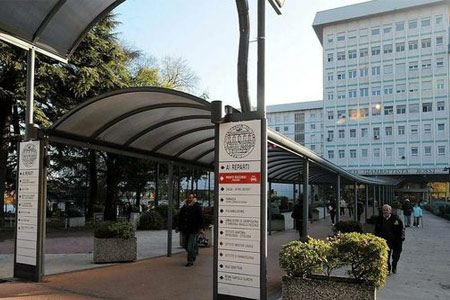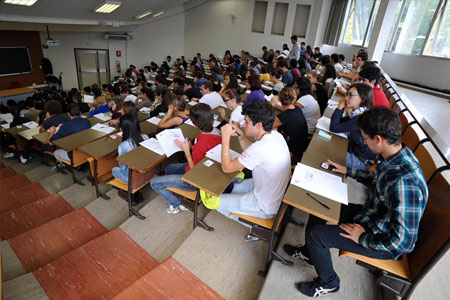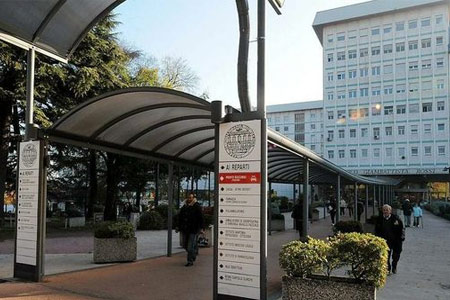- Authors:
-
Rosato, Stefano; Santini, Francesco; Barbanti, Marco; Biancari, Fausto; D'Errigo, Paola; Onorati, Francesco; Tamburino, Corrado; Ranucci, Marco; Covello, Remo Daniel; Santoro, Gennaro; Grossi, Claudio; Ventura, Martina; Fusco, Danilo; Seccareccia, Fulvia
- Title:
-
Transcatheter Aortic Valve Implantation Compared With Surgical Aortic Valve Replacement in Low-Risk Patients
- Year:
-
2016
- Type of item:
-
Articolo in Rivista
- Tipologia ANVUR:
- Articolo su rivista
- Language:
-
Inglese
- Referee:
-
No
- Name of journal:
- CIRCULATION. CARDIOVASCULAR INTERVENTIONS.
- ISSN of journal:
- 1941-7640
- N° Volume:
-
9
- Number or Folder:
-
5
- Page numbers:
-
1-8
- Keyword:
-
EuroSCORE II; TAVI; TAVR; aortic valve replacement; aortic valve stenosis; low-risk; surgical; Aged; Aged, 80 and over; Aortic Valve; Aortic Valve Stenosis; Europe; Female; Follow-Up Studies; Humans; Male; Risk; Risk Assessment; Risk Factors; Survival Analysis; Treatment Outcome; Transcatheter Aortic Valve Replacement
- Short description of contents:
- Background - The proven efficacy of transcatheter aortic valve implantation (TAVI) in high-risk patients is leading to the expansion of its indications toward lower-risk patients. However, this shift is not supported by meaningful evidence of its benefit over surgical aortic valve replacement (SAVR). This analysis aims to describe outcomes of TAVI versus SAVR in low-risk patients. Methods and Results - We compared the outcome after TAVI and SAVR of low-risk patients (European System for Cardiac Operative Risk Evaluation II [EuroSCORE II] <4%) included in the Observational Study of Effectiveness of SAVR-TAVI Procedures for Severe Aortic Stenosis Treatment (OBSERVANT) study. The primary outcome was 3-year survival. Secondary outcomes were early events and major adverse cardiac and cerebrovascular events at 3 years. Propensity score matching resulted in 355 pairs of patients with similar baseline characteristics. Thirty-day survival was 97.1% after SAVR and 97.4% after TAVI (P=0.82). Cardiac tamponade, permanent pacemaker implantation, major vascular damage, and moderate-to-severe paravalvular regurgitation were significantly more frequent after TAVI compared with SAVR. Stroke rates were equal in the study groups. SAVR was associated with higher risk of cardiogenic shock, severe bleeding, and acute kidney injury. At 3 years, survival was 83.4% after SAVR and 72.0% after TAVI (P=0.0015), whereas freedom from major adverse cardiac and cerebrovascular events was 80.9% after SAVR and 67.3% after TAVI (P<0.001). Conclusions - In patients with low operative risk, significantly better 3-year survival and freedom from major adverse cardiac and cerebrovascular events were observed after SAVR compared with TAVI. Further studies on new-generation valve prostheses are necessary before expanding indications of TAVI toward lower-risk patients.
- Note:
- The page range is based on PDF file available on the journal website
- Product ID:
-
109434
- Handle IRIS:
-
11562/997843
- Last Modified:
-
November 27, 2022
- Bibliographic citation:
-
Rosato, Stefano; Santini, Francesco; Barbanti, Marco; Biancari, Fausto; D'Errigo, Paola; Onorati, Francesco; Tamburino, Corrado; Ranucci, Marco; Covello, Remo Daniel; Santoro, Gennaro; Grossi, Claudio; Ventura, Martina; Fusco, Danilo; Seccareccia, Fulvia,
Transcatheter Aortic Valve Implantation Compared With Surgical Aortic Valve Replacement in Low-Risk Patients
«CIRCULATION. CARDIOVASCULAR INTERVENTIONS.»
, vol.
9
, n.
5
,
2016
,
pp. 1-8
Consulta la scheda completa presente nel
repository istituzionale della Ricerca di Ateneo 








